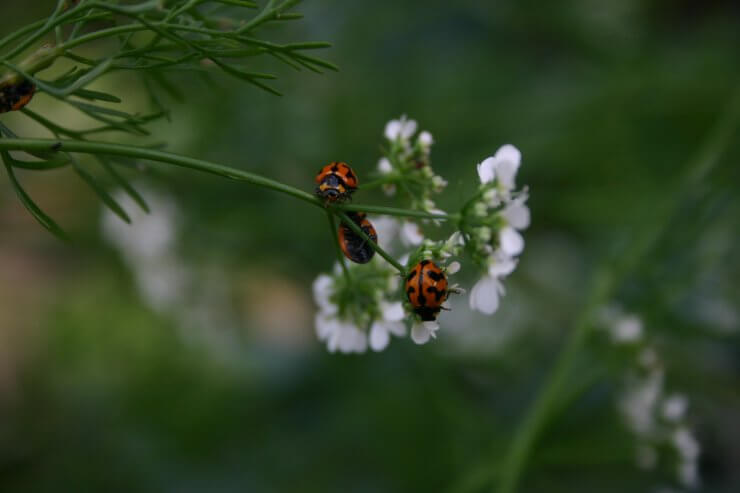
If you love good guacamole, you probably already know who is eating your cilantro – everybody! Cilantro is thought to be one of the first herbs enjoyed by humans, going back at least as far as 5000 BC. Well, except for the 25% of people who think it tastes like soap, but for the rest of us, cilantro is a staple in good cuisine! Then you have the bonus: their seeds—also known as the spice called coriander. In the garden though, there may be more than a plate of nachos using up all your cilantro – garden pests! You might be looking at your plant, full of holes, and wondering, “what is eating my cilantro leaves?”
Cilantro, an annual plant, can grow in open land, in raised beds, and in containers outdoors and indoors. But no matter how or where you plant it, it can become a target of pests. The good news is that it’s fragrant enough to scare off a lot of them.
Cilantro as Companion Plants
Cilantro is a friendly garden plant. Its delicate white and pink flowers are not only beautiful but they attract beneficial insects that protect your plants by eating pests. In turn, bushy plants such as tomatoes—or even tall flowers like cosmos and zinnia—can give cilantro the partial shade they need to thrive.
Basil, mint, yarrow, dill, and tansy all work well with cilantro. But keep fennel and cilantro apart—in fact, fennel is best grown apart from most other plants. Aphids tend to pester cilantro, so plant sweet alyssum, coreopsis, and chervil, which all deter aphids, to minimize damage.
Cilantro as a Pest Deterrent
Cilantro’s strong scent serves as a decent pest repellent. Nevertheless, pests like aphids on your cilantro, left unchecked, can damage and destroy your beautiful plants. Keeping a close watch on your plants during regular daily inspections will help you spot any pests before they can do irreparable harm. Healthy cilantro can bounce back from pest damage if you catch the pests quickly.
What is Eating My Cilantro Leaves?
If you see yellowing leaves and clusters of small “bumps” on the underside of leaves, you have Aphids. To get rid of them import ladybugs or plants like marigolds that attract them and apply insecticidal soap.
If you’re losing foliage, you may have Army Worms. To get rid of them, pick them off and drop in soapy water or apply Bacillus thuringiensis.
If you have thin, spindly plants; yellowed flowers, and they’re looking dry in general, you may have Leaf Hoppers. Simply apply neem oil (a good practice in general for most plants), insecticidal soap, or pyrethrum.
The Best Way to Keep Pests off Your Cilantro
- Pick off the pests. Use your garden gloves to remove the pests by hand. After removal, destroy pests by drowning them in a bucket of soapy water or crushing them with your foot. Handpicking isn’t efficient or practical for very small pests but works well with larger pests.
- Apply insecticidal soap. Insecticidal soap is organic. The potassium salts in insecticidal soap help remove an insect’s protective waxes, causing the destruction of insect membranes and killing them. Mix the soap with water to create your solution and apply directly to insects on any plants. While insecticidal soap is less apt to affect other organisms, certain plants might be sensitive to the soap and can suffer leaf burn.
- Apply horticultural oils. Combine plant- or petroleum-based oils with water to produce horticultural sprays. Neem oil, for instance, is derived from seed extracts of the neem plant. Oil-based sprays block an insect’s air holes, interfere with an insect’s metabolism, disrupt insect feeding, and inhibit insect growth. Like insecticidal soaps, horticultural oils can cause plant injury if not properly diluted.
If your cilantro is infested, act quickly. If you discover that your cilantro is infested with anything, you need to apply the treatment methods recommended above as soon as possible.
Want to grow cilantro at home?
Cilantro, or coriander, brings a distinctive flavor to many favorite ethnic cuisines including Mexican, Thai, and Indian. But you don’t have to cross the border to have fresh cilantro—you can grow it in your garden or even indoors and enjoy this tasty herb year-round. With this collection, you get all the details that go into growing and harvesting flavorful cilantro and its seed form, coriander. Get recipes for a fiesta of sweet and savory dishes that make it all the more rewarding to grow your own cilantro. Get it all in our Celebrate Cilantro Collection right now!


 Previous
Previous

I know what is eating my cilantro – deer! They go for it above everything else.